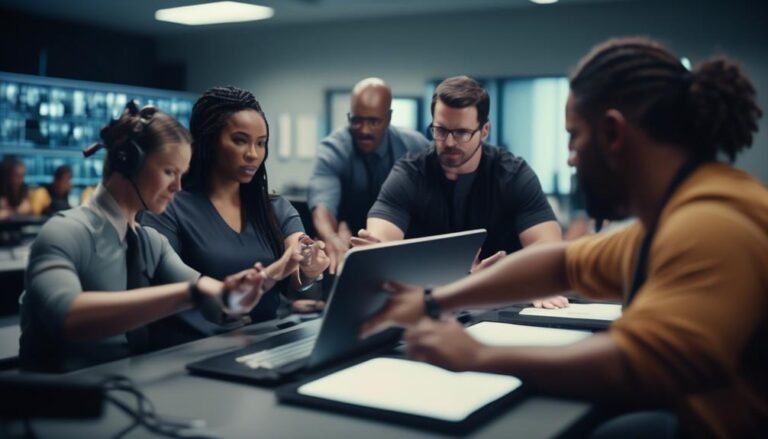The Impact of Advanced Training Technologies on Employee Learning
The dynamic landscape of employee training has witnessed a remarkable transformation with the integration of advanced training technologies. As organizations strive to optimize their workforce's potential, it is imperative to examine the profound impact of these innovations on employee learning.
From personalized skill development to overcoming traditional learning barriers, advanced training technologies have redefined the way employees engage with learning materials. However, amidst these advancements, a critical question arises: how do these technologies effectively measure the learning outcomes and translate them into tangible organizational benefits?
Let's explore the intricate interplay between advanced training technologies and employee learning, and uncover the implications for the future of workforce development.
Key Takeaways
- Integration of interactive simulations and hands-on, immersive learning experiences replicate real-life scenarios and develop practical skills in a safe environment.
- Adaptive learning techniques personalize the learning process, tailoring content and delivery to individual learning pace, style, and performance, resulting in a customized learning experience and improved retention and application of knowledge.
- Enhanced learning engagement is achieved through dynamic learning environments, active participation in realistic scenarios, and gamified learning that incorporates game elements, challenges, rewards, and competition, making learning enjoyable and stimulating, and increasing motivation to seek learning opportunities.
- Overcoming learning barriers involves breaking down content into small, easily digestible segments through microlearning, managing cognitive load through tools and resources, using motivation techniques such as setting clear learning goals, offering rewards and recognition, fostering a supportive learning environment, and ensuring training relevance and appropriate challenge levels.
Evolution of Training Methods
Throughout the history of employee training, the evolution of training methods has been pivotal in meeting the dynamic needs of the workforce and adapting to technological advancements.
One significant advancement in training methods is the integration of interactive simulations. These simulations provide employees with a hands-on, immersive learning experience that replicates real-life scenarios. By engaging with these interactive simulations, employees can develop practical skills in a safe and controlled environment, enhancing their overall learning experience.
Additionally, the implementation of adaptive learning techniques has revolutionized training methods. This approach personalizes the learning process by tailoring content and delivery to match the individual's learning pace, style, and performance. By utilizing adaptive learning techniques, employees can receive a customized learning experience that is more effective and efficient, leading to improved retention and application of knowledge.
As technology continues to advance, the evolution of training methods will undoubtedly persist. Embracing interactive simulations and adaptive learning techniques not only enriches the learning experience but also ensures that employee training remains effective and relevant in a rapidly changing professional landscape.
Enhanced Learning Engagement
The integration of interactive simulations and adaptive learning techniques has not only revolutionized training methods but has also significantly enhanced employee learning engagement.
Interactive simulations provide a dynamic learning environment where employees can actively participate in realistic scenarios, allowing them to apply knowledge in a practical context. This hands-on approach fosters higher levels of engagement as employees are more likely to retain information through experiential learning.
Moreover, gamified learning, which incorporates game elements into the learning process, has been instrumental in capturing and maintaining employee interest. By introducing elements such as challenges, rewards, and competition, gamified learning makes the learning experience more enjoyable and stimulating. This, in turn, motivates employees to actively seek out learning opportunities and invest themselves in the training process.
The combination of interactive simulations and gamified learning has proven to be a powerful engagement tool, creating a more immersive and compelling learning experience for employees. As a result, organizations are witnessing increased participation, higher knowledge retention, and ultimately, a more skilled and knowledgeable workforce.
Personalized Skill Development
Significant advancements in training technologies have facilitated the implementation of personalized skill development programs for employees, leading to targeted and effective learning experiences. Personalized skill development is revolutionizing traditional training methods by providing tailored learning experiences that cater to individual employee needs and preferences. This approach to learning leverages individualized coaching and adaptive learning platforms to create a highly personalized learning journey. Here are four key elements of personalized skill development:
- Customized Learning Paths: Employees are guided through personalized learning paths based on their existing skills, knowledge gaps, and career aspirations.
- Adaptive Content Delivery: Learning content is dynamically adjusted based on individual progress and performance, ensuring that employees receive the right level of challenge and support.
- Real-time Feedback and Support: Employees receive immediate feedback and personalized support to address their specific learning needs and challenges.
- Data-Driven Insights: Advanced analytics and reporting provide valuable insights into individual learning behaviors, enabling continuous improvement and refinement of personalized learning programs.
Through personalized skill development, employees can enhance their capabilities in a way that is tailored to their unique learning styles and professional goals.
Overcoming Learning Barriers
Despite the challenges that may arise, organizations are actively seeking effective strategies to overcome learning barriers and ensure the successful development of their employees' skills.
One significant barrier to effective learning is the issue of cognitive load. Employees may struggle to process and retain information when they are overwhelmed with too much new material or complex instructions. To address this, organizations can utilize techniques such as microlearning, where content is broken down into small, easily digestible segments. Additionally, providing employees with access to tools and resources that help manage cognitive load, such as interactive simulations and job aids, can greatly enhance their learning experience.
Another crucial aspect of overcoming learning barriers is the implementation of motivation techniques. Employees may lack the intrinsic motivation to engage in learning, especially if they perceive the training as irrelevant or too challenging. To combat this, organizations can employ strategies like setting clear learning goals, offering rewards and recognition for achievements, and fostering a supportive learning environment.
Measuring Training Effectiveness
To evaluate the impact of the strategies employed to overcome learning barriers, measuring training effectiveness becomes imperative for organizations seeking to ensure the continuous development and proficiency of their employees. Effective measurement allows organizations to determine the return on investment in training, identify areas for improvement, and make informed decisions about future training initiatives.
When measuring training effectiveness, organizations can employ various methods, including:
- Quantitative Assessment: Utilizing metrics such as test scores, performance improvements, and completion rates to quantitatively measure the impact of training programs on employee learning and development.
- Qualitative Analysis: Conducting interviews, surveys, and focus groups to gather qualitative data on employees' perceptions of the training, its applicability to their roles, and the extent to which it has contributed to their professional growth.
- Feedback Mechanisms: Implementing feedback mechanisms to collect real-time input from employees regarding the effectiveness of the training in addressing their learning needs and enhancing their skills.
- Performance Evaluation: Analyzing post-training job performance to assess the practical application of newly acquired knowledge and skills in the workplace, providing valuable insights into the overall effectiveness of the training.
Conclusion
In conclusion, the impact of advanced training technologies on employee learning has been significant. Research shows that 87% of employees feel more engaged and motivated to learn using these technologies.
They have also helped to personalize skill development, overcome learning barriers, and measure training effectiveness more accurately.
As training methods continue to evolve, organizations can expect to see even greater improvements in employee learning and development.







